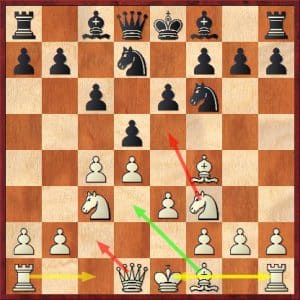Whether you’re a novice learning the ropes or a seasoned player honing your skills, the strategies behind winning chess are both an art and a science.
In this guide, we’ll unravel the mysteries of this classic board game, exploring the tactics that turn a chessboard into a realm of strategic genius.
Keep reading!
Table of contents
- How to Win Chess
- #1. Control the Center:
- #2. Develop Your Pieces Early:
- #3. King Safety:
- #4. Pawn Structure Awareness:
- #5. Use Open Files:
- #6. Avoid Unnecessary Weaknesses:
- #7. Pawn Storms:
- #8. Understand Pawn Structure:
- #9. Double Rooks on Open Files:
- #10. Use Outposts for Knights:
- #11. Breaks in Closed Positions:
- #12. Pin and Skewer Tactics:
- #13. Pawn Majority:
- #14. Queen Out Early Risks:
- #15. Knights on the Rim:
- #16. Exchange Pieces Carefully:
- #17. Pawn Chains and Weak Links:
- #18. Be Mindful of Time:
- #19. Understand Endgame Fundamentals:
- #20. Recognize Patterns:
- #21. Disrupt Your Opponent’s Plans:
- #22. Plan Ahead:
- #23. Stay Calm in Time Trouble:
- #24. Learn from Losses:
- How can I improve my chess strategy?
- Conclusion
- Frequently Asked Questions
- References
- Recommendations
How to Win Chess
Mastering chess involves a blend of foresight, strategy, and a deep understanding of the game’s nuances. Here are 24 smart strategies to enhance your chances of victory:
#1. Control the Center:
Why: The center is the heart of the board. Controlling it provides more mobility for your pieces and better strategic options.
How: Place your pawns and pieces to influence and occupy central squares.
#2. Develop Your Pieces Early:
Why: Early development allows for quicker mobilization and better coordination.
How: Move knights and bishops early, avoiding unnecessary pawn moves.
#3. King Safety:
Why: A safe king is crucial. Castle early to tuck your king away from the center.
How: Castle kingside or queenside depending on the position.
#4. Pawn Structure Awareness:
Why: Understand pawn structures for effective planning and strategic decisions.
How: Study common pawn structures and their implications on piece play.
You should read: How Tall is Trippie Redd? Everything About the Rapper
#5. Use Open Files:
Why: Open files provide pathways for your rooks to dominate the board.
How: Aim to control and occupy open files with your rooks.
#6. Avoid Unnecessary Weaknesses:
Why: Weaknesses become targets for your opponent. Minimize pawn and positional weaknesses.
How: Think twice before making pawn moves that create long-term weaknesses.
#7. Pawn Storms:
Why: Create pawn storms to open lines and attack your opponent’s king.
How: Advance pawns to create threats, especially against a castled king.
#8. Understand Pawn Structure:
Why: Recognizing pawn structures guides your strategic decisions.
How: Analyze games to understand how pawn structures influence piece play.
#9. Double Rooks on Open Files:
Why: Doubled rooks on an open file exert immense pressure.
How: Coordinate your rooks on open files for a powerful presence.
Also check out this content: How Tall is Jack Skellington? All the Facts and Details
#10. Use Outposts for Knights:
Why: Knights on outposts control key squares and are difficult to dislodge.
How: Seek squares deep in your opponent’s position for your knights.
#11. Breaks in Closed Positions:
Why: Breaks open closed positions to create new opportunities.
How: Identify pawn breaks to challenge your opponent’s structure.
#12. Pin and Skewer Tactics:
Why: Pinning pieces restrict their movement; skewering creates double attacks.
How: Look for opportunities to pin or skewer your opponent’s pieces.
#13. Pawn Majority:
Why: Utilize pawn majorities to create passed pawns and advance them.
How: Identify which side of the board you have a pawn majority and push.
#14. Queen Out Early Risks:
Why: Bringing the queen out early can expose it to attacks.
How: Develop minor pieces first; let the queen join the action later.
#15. Knights on the Rim:
Why: Knights on the edge of the board have limited mobility.
How: Place knights towards the center for greater influence.
You should read: How Big is 5 Inches? 6 Items with Accurate Measurement
#16. Exchange Pieces Carefully:
Why: Thoughtful exchanges maintain a favorable balance of material.
How: Consider the positional implications before trading pieces.
#17. Pawn Chains and Weak Links:
Why: Solid pawn chains provide structure; weak links become targets.
How: Target weak links in your opponent’s pawn structure.
#18. Be Mindful of Time:
Why: Time management is crucial. Avoid time pressure in critical positions.
How: Plan moves efficiently; consider the clock during each move.
#19. Understand Endgame Fundamentals:
Why: A solid endgame foundation can turn a small advantage into a win.
How: Study essential endgame principles and practice endgames regularly.
You should read: How Big is 5 Inches? 6 Items with Accurate Measurement
#20. Recognize Patterns:
Why: Pattern recognition helps anticipate and capitalize on recurring themes.
How: Study classic games to internalize common patterns.
#21. Disrupt Your Opponent’s Plans:
Why: Prevent your opponent from executing their plans smoothly.
How: Identify your opponent’s intentions and disrupt their harmony.
#22. Plan Ahead:
Why: Strategic planning guides your moves towards a cohesive goal.
How: Consider long-term plans based on the position.
#23. Stay Calm in Time Trouble:
Why: Panic in time trouble can lead to blunders. Stay calm and focused.
How: Practice time management and maintain composure under pressure.
#24. Learn from Losses:
Why: Losses provide valuable lessons. Analyze and learn from your mistakes.
How: Review games, especially losses, to identify areas for improvement.
Check out this related content: Is 75 Degrees Really Hot? (Explained)
How can I improve my chess strategy?
Improving your chess strategy involves a combination of studying, practicing, and refining your understanding of the game. Here are some practical steps to enhance your chess strategy:
- Study Famous Games
- Understand Opening Principles
- Practice Regularly
- Analyze Your Games
- Learn from Mistakes
- Master Basic Endgames
- Practice Visualization
- Study Strategic Themes
- Play with a Plan
- Diversify Openings
- Engage in Tactical Training
- Seek Feedback
Conclusion
Whether you’re aiming for a checkmate in a few moves or navigating the complexities of an endgame, the journey of becoming a strategic genius in chess is both challenging and immensely rewarding.
So, position your pieces, plan your moves, and let the chessboard become your canvas for tactical brilliance!
Frequently Asked Questions
Begin with the basics. Learn how each piece moves, understand the rules, and practice regularly. Online platforms and chess apps offer interactive lessons for beginners.
Controlling the center provides more mobility for your pieces, allowing for better coordination and strategic options. It also restricts your opponent’s movements, giving you a positional advantage.
Study famous chess games, understand common opening strategies, and practice visualization. Analyzing your own games and learning from your mistakes is crucial for improvement.
Yes, sacrificing pieces strategically can lead to a powerful attack or positional advantage. However, it requires careful calculation and should align with your overall strategy.
Focus on coordinating your pieces to control key squares around your opponent’s king. Learn common checkmating patterns, and always be mindful of your opponent’s counterplays.
References
- wikihow.com– How to Win Chess
- wikihow.com– How to become a better chess player
- chess.com– How to Win a Chess game
Recommendations
- 26 Legitimate Ways to Get a Costco Student Membership for Free
- What Age Do You Graduate High School?
- Which Group is a Primary Supporter of Hunter Education?
- How Tall is Trippie Redd? Everything About the Rapper
- How Tall is Jack Skellington? All the Facts and Details
- How Big is 5 Inches? 6 Items with Accurate Measurement






